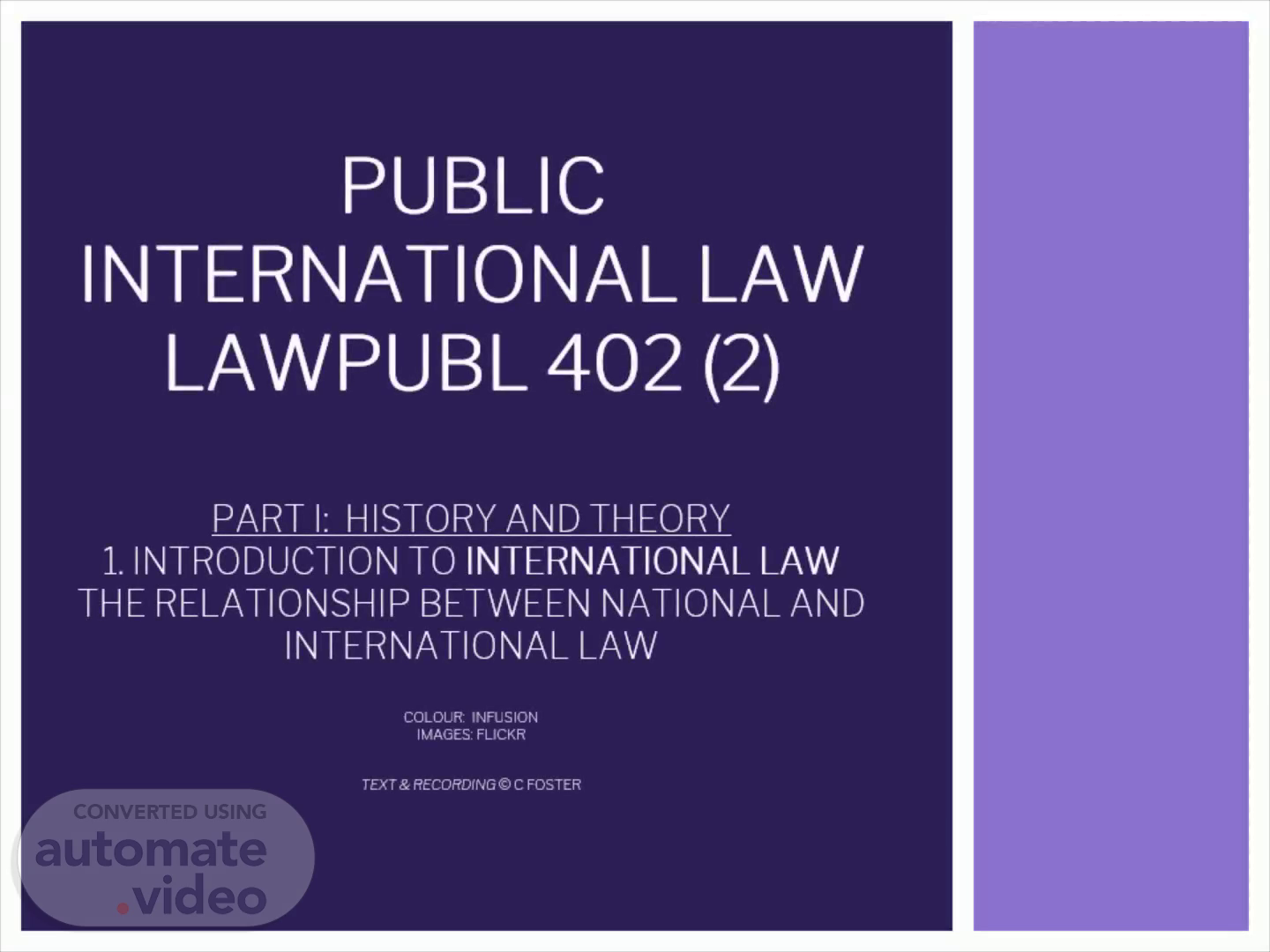
PUBLIC INTERNATIONAL LAW LAWPUBL 402 (2) PART I: HISTORY AND THEORY 1. INTRODUCTION TO INTERNATIONAL LAW THE RELATIONSHIP BETWEEN NATIONAL AND INTERNATIONAL LAW COLOUR: INFUSION IMAGES: FLICKR TEXT & RECORDING © C FOSTER
Scene 1 (0s)
. PUBLIC INTERNATIONAL LAW LAWPUBL 402 (2) PART I: HISTORY AND THEORY 1. INTRODUCTION TO INTERNATIONAL LAW THE RELATIONSHIP BETWEEN NATIONAL AND INTERNATIONAL LAW COLOUR: INFUSION IMAGES: FLICKR TEXT & RECORDING © C FOSTER.
Scene 2 (21s)
Revise what you will already know about the relationship between New Zealand law and international law to ensure you are placed to evaluate the significance of international law vis-à-vis New Zealand law throughout the course..
Scene 3 (46s)
What is meant by the following? Conclusion - Once a treaty’s text has been agreed between the States involved in its negotiation, the text becomes final and we say that the treaty has been ‘concluded’. Adoption - If it is a multilateral treaty it will usually be ‘concluded’ at a conference or summit meeting of the negotiating parties and formally ‘adopted’ by the conference..
Scene 4 (1m 27s)
Signature - when a treaty, whether bilateral or multilateral, is concluded, it will most often be signed by those parties who are ready to do so. Ratification – many treaties, especially multilateral treaties, specify that in addition to signature, their subsequent ‘ratification’ or acceptance is also required by a State in order for the treaty to become binding on the State..
Scene 5 (3m 17s)
Which branch of government has the authority under the NZ constitution to enter into treaties on behalf of NZ? The Executive, Parliament or the Judiciary? What is the source of this authority? Who negotiates treaties for NZ?.
Scene 6 (5m 5s)
. Sometimes. Eg Second Optional Protocol to the ICCPR, to which New Zealand became party in 1990. To do this we had to remove the death penalty from our law, so we had to remove the death penalty for treachery in the armed forces. See the Abolition of the Death Penalty Act 1989 ..
Scene 7 (6m 39s)
. Eg United Nations Convention on the Law of the Sea Act 1996 This Act gives effect to Part XI of the United Nations Convention on the Law of the Sea 1982 (UNCLOS) dealing with deep sea bed mining by establishing a licensing system in NZ for deep seabed mining..
Scene 8 (8m 18s)
. Sometimes not. Eg the International Covenant on Civil and Political Rights (ICCPR).
Scene 9 (9m 18s)
What is the extent of Parliament’s involvement in treaty-making? Since 1997 a new procedure has been employed in New Zealand whereby all multilateral treaties, and major bilateral treaties of particular significance, are tabled in the House of Representatives before New Zealand becomes party to them. This process has roots in the Ponsonby Rule, a similar procedure employed in the UK since 1924, under which treaties are tabled for 21 sitting days in the House before the Executive can enter into them. See Standing Orders of the House of Representatives 397-400; Cabinet Manual 2008 7.112-7.122 in your materials..
Scene 10 (11m 8s)
When a treaty is presented to the New Zealand House of Representatives it has to be accompanied by a national interest analysis. As seen in the Standing Orders, the national interest analysis addresses: reasons for New Zealand becoming party to the treaty, advantages and disadvantages of becoming party to the treaty, obligations that will be imposed and the position in respect of reservations, economic, social and cultural effects of the treaty, costs of compliance, the likely future development of any protocols to the treaty, the way in which New Zealand will implement the treaty, a statement of the consultations that have been undertaken or are proposed within the New Zealand community in relation to the treaty, whether the treaty provides for withdrawal or denunciation..
Scene 11 (12m 41s)
Treaties are not part of NZ law, even though New Zealand is bound by international law to apply a treaty to which we are party. This is sometimes called a dualist system. Dualism: “two systems”..
Scene 12 (14m 27s)
Eg Diplomatic Privileges and Immunities Act 1968 (see s 5(1)) (giving effect to the Vienna Convention on Diplomatic Relations 1961, 500 UNTS 95, found in Schedule 1 to the Act). That is done in relation to the provisions dealing with: inviolability of diplomatic missions and of the diplomatic bag and other substantive immunities “Subject to subsection (6), the provisions of Articles 1, 22 to 24, and 27 to 40 of the Convention shall have the force of law in New Zealand.”.
Scene 13 (15m 38s)
The idea that customary international law is part of the law of England … was articulated by Lord Mansfield in 1737 and adopted by Blackstone: “the law of nations, whenever any question arises which is properly the object of its jurisdiction, is here adopted in its full extent by the common law; and is held to be a part of the law of the land.” Blackstone’s Commentaries IV, chapter 5, cited by Shaw, 6 th Ed, p 140. On a more nuanced view, “the position in England is not that custom forms part of the common law…but that it is a source of English law that the courts may draw upon as required”. J Brierly, “International Law in England” 51 LQR 1935, 24, 31, cited by Shaw, 6 th Ed, 147..
Scene 14 (17m 36s)
Recap of general points. .
Scene 15 (19m 59s)
The M ā ori voice in NZ treaty-making. .